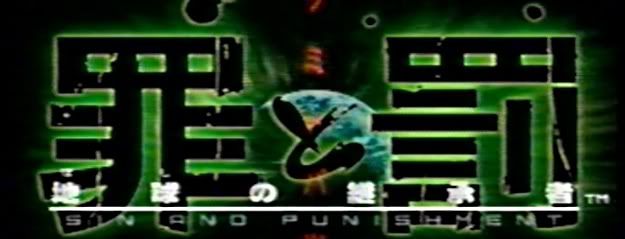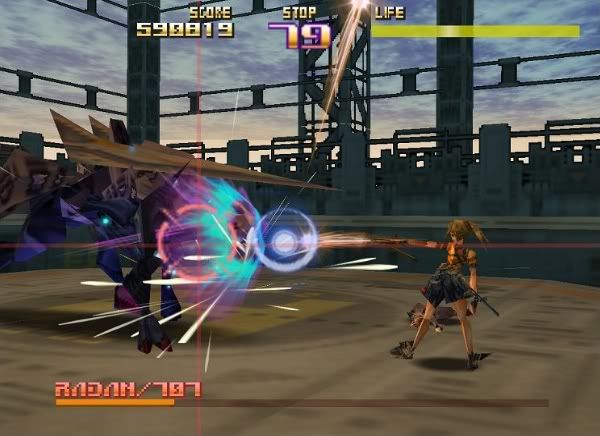
Branching out from Metal Gear Solid’s owner Konami back in 1992, a group of talented programmers pooled together their resources to form the Developer Legend known as Treasure. Treasure; consisting of around 40 to 50 staff members, and sometimes more when working with Publishers like Nintendo and Sega, have created remarkable gaming experiences time and time again, whether it be with colourful platformers like Dynamite Headdy, insanely difficult shooters like Ikaruga, or even Anime and Cartoon licences like Bleach and Astro Boy. Many of their hits are placed within the realm of 2D, and this is where Treasure has mastered its craft. Most of their 3D titles however, are a little less remarkable; Wario World on the Gamecube suffered from a short lifespan and repetitive gameplay, and Stretch Panic for Playstation 2 was plagued with bad controls and dull surroundings.
Thankfully then, Treasure struck gold with their second (after Bangai-O) Nintendo 64 game, Sin & Punishment: Successor of the Earth. SotE combined a 3D-rendered world with gunplay on a 2D plane, and the result was nothing short of spectacular. Unfortunately, due to arriving so late in the N64’s life, and with a new generation of machines ready to hit the market, the excellence of Sin and Punishment was condemned to remain in Japan evermore.
At least, until Nintendo announced the feature of downloadable retro games for their 5th Home Console, it was. Despite it being one of the more popular imported games of the time, many wished for an official translation and localization of Sin & Punishment, as this new download service would allow it to happen. And happen it did, at the very first Hanabi Festival, a limited time of Virtual Console releases that never made it to the region they would be released into now. Through this, thousands of gamers got to sample some of Treasure’s finest work, and because of this event, Treasure’s very first official sequel to one of their own franchises was green-lit. Whilst we all wait patiently for Sin and Punishment 2, how about a recap of the first game?

Even before text translation, Sin & Punishment’s Voice Acting, itself a rarity for a Nintendo 64 game, was cast entirely in English, with only Japanese subtitles. An unusual move to be sure, almost certainly cementing its cult status in the minds of shooter fans worldwide, and providing a small glimmer of hope for the game to be brought over in the meantime.
Sin & Punishment casts a grim future of Mankind, where an entirely new species of animal had to have been created to feed an overflowing Human Population. These creatures, known as Ruffians, rebel and attack the people of Japan, as a result of their own mutation. A group called the Armed Volunteers attempt to destroy these creatures, although they are also against the Japanese population itself. Your characters, Saki and Airen, are part of another, much smaller organization, named the Savior Group, led by a mysterious figure, Achi; all of whom oppress both the Armed Volunteers and the Ruffians. The game starts with you leading these three through a warzone to steal a transport, although the story soon takes interesting twists and meanders, accumulating in a Planetary Battle. Rest assured, this one gets epic.
Admittedly, the story is a little difficult to understand via the in-game explanation, as the voices themselves are fairly stale, and at times drowned out by the background music (excellent though it may be), but you can near-enough get the gist of it.

The game adapts an on-rails mechanic, although with the freedom of left and right movement left to the player, and dedicated Jump and Dodge Roll controls. For the most part, you’ll be aiming a cursor with the analogue stick, and firing at Ruffians and Targets with the Shoulder Button. How powerful your shots are is left up to you; the main button switches between a lock-on mode similar to Lylat Wars that makes aiming easier, but halves the strength of your bullets, and the other mode gives up aim completely to you, but maximises the power of your weapon. This simple little mechanic helps inject a little variety into repeat play, as well as challenge your high scores. And in this game, High Score is an understatement; just try to count how many Digits your total will end up with.
Much like Squall’s signature weapon in Final Fantasy VII, Airen and Saki’s weapons are dual Gun-Blades, so alongside the shoot-em-up action there’s a little swordplay, although could be defined as more of an automatic gesture when enemies get too close; all it takes for a swipe of your sword is a press of the fire trigger, and for most bosses and armoured targets this part of the weapon is essential. Sometimes you have stalemate situations, where you need to bash the trigger like mad to win a clash of blades, and this adds nicely to the amount of variety Sin & Punishment provides.
One thing that did have resulting problems in the transfer from then to now is the control layout. Although you are given the choice of either a Gamecube Pad or a Classic Controller, neither really feels like the right one for the job. It isn’t a game-breaking obstacle, but an obstacle nonetheless, and one that’ll require a bit of adapting and time to get over. It’s oh-so worth doing as such though.

Pitting Sin & Punishment against the games of today in the looks department, or even against recent Wiiware titles, would be rather unfair, even if the general blocky style to the game hasn’t aged too well. For the host console it debuted on though, S&P looks brilliant, and the number of enemies and explosions on screen at times puts Dead Rising Wii to shame. Even at moments like an ill-fated train ride and a platform diving and ducking through the air and hordes of foes, the framerate never lets up, and the game constantly throws curveballs and unexpected moments at you. Each cutscene flows well, and maintain the right balance between viewing and playing.
The main game is no slouch in the adversity department either; the fights start off simple enough, but by the end you’d better have Zen-like reactions. And once that’s done, you can try setting the game to Normal Difficulty, and aiming for the top of the Ranking Boards. In fact, why not select a favourite part of the game to play again? Despite there being no Multiplayer feature, there is a ton of replay value to be had here, and even for a higher price point of 1200, every individual one is worth it. Just make sure you buy those points online, m’kay?

 Sign In
Sign In By Phoenom
By Phoenom 8764
8764
 Captian
Captian 

 Link to this post:
Link to this post:  Subscribe to this topic
Subscribe to this topic Game Details
Game Details
 Out now
Out now  Out now
Out now  Out now
Out now  Out now
Out now  I own this game
I own this game
 I want this game
I want this game Features
Features





 Top
Top


Who owns this game?
tiamat1990
Sandy Wilson
Agul